Wondering if a 1960 penny you found in your change is worth more than just one cent? You’re not alone! In this guide, we’ll break down the value of 1960 pennies, what factors affect their price, and which varieties and errors make some of these coins highly collectible.
We’ll also explore a bit of history behind the 1960 penny, examine its design features, and look at the most valuable errors you might be lucky enough to come across.
Let’s dive in!
1960 Penny Value Chart*
(*Values shown are for coins graded Red (RD), which are the most desirable color designation for copper coins.)
| Mint Mark & Variety | MS63 | MS65 | MS67 |
|---|---|---|---|
| 1960 (P) No Mint Mark – Large Date | $4 | $14 | $375 |
| 1960 (P) No Mint Mark – Small Date | $6 | $27 | $525 |
| 1960 D – Large Date | $8 | $16 | $475 |
| 1960 D – Small Date | $10 | $20 | $340 |
| Proof Pennies | PR60 | PR65 | PR69 |
|---|---|---|---|
| 1960 (P) Large Date – Proof | $5 | $17 | $160 |
| Cameo / Deep Cameo | $7 / $8 | $28 / $40 | $325 / $2,650 |
| 1960 (P) Small Date – Proof | $6 | $20 | $625 |
| Cameo / Deep Cameo | $8 / $12 | $50 / $75 | $650 / $— |
History of the 1960 Penny

1960 marked the second year that Lincoln pennies featured the Lincoln Memorial on the reverse side.
The design includes a subtle but significant detail: Lincoln’s statue can be seen seated within the Memorial, making this one of the rare coins to depict the same historical figure on both sides.
The reverse was designed by Frank Gasparro, who was then the Assistant Engraver at the U.S. Mint. He later became the Chief Engraver, a role he held for nearly 16 years.
That year, more than 2 billion pennies were struck between the Philadelphia and Denver Mints, with nearly 75% coming from Denver. Both mints also produced two varieties of the coin: the Large Date and Small Date versions.
The Lincoln Memorial reverse remained in use for five decades, until it was retired in 2009 to mark the 200th anniversary of Lincoln’s birth. It was replaced by the Union Shield design, which continues to appear on pennies today.
Features of the 1960 Penny
The Obverse of the 1960 Penny
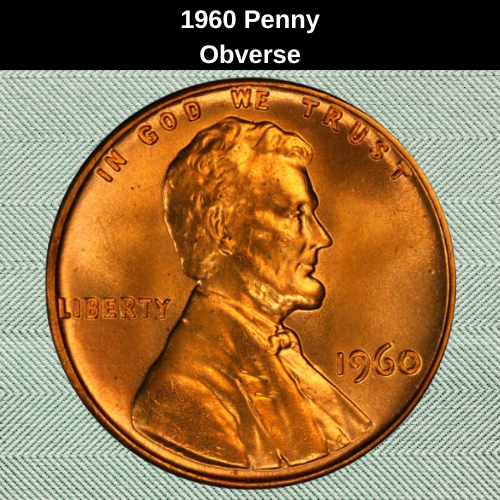
The “heads” side of the 1960 penny — known as the obverse — carries one of the most iconic images in American coinage: a right-facing profile of President Abraham Lincoln. This same portrait has appeared on every Lincoln cent since its debut in 1909.
The design was created by Victor David Brenner, who also crafted the original wheat ear reverse used from 1909 to 1958. Like many coin designers, Brenner wished to sign his work. His first proposal was to place his full signature beneath Lincoln’s portrait, but when that was rejected, he settled for his initials (V.D.B.) on the reverse instead.
However, controversy followed. Critics claimed the initials were too prominent — more like self-promotion than a subtle signature. As a result, the initials were removed altogether shortly after the coin’s release.
It wasn’t until 1918 that Brenner’s initials were reinstated — this time more discreetly, on the lower edge of Lincoln’s shoulder (the “cut-off”), where they remain to this day.
Other features of the obverse include:
- “IN GOD WE TRUST” arched above Lincoln’s head.
- “LIBERTY” positioned to the left.
- The date appears on the right.
For 1960 pennies:
- Large Date variety: the top of the “9” is higher than the “1”, and the “6” is visibly larger.
- Small Date variety: the “9” aligns more closely with the “1”, and the “6” is smaller and more compact.
Finally, pennies struck at the Denver Mint carry a small “D” mint mark beneath the date. Those minted in Philadelphia have no mint mark at all.
The Reverse of the 1960 Penny
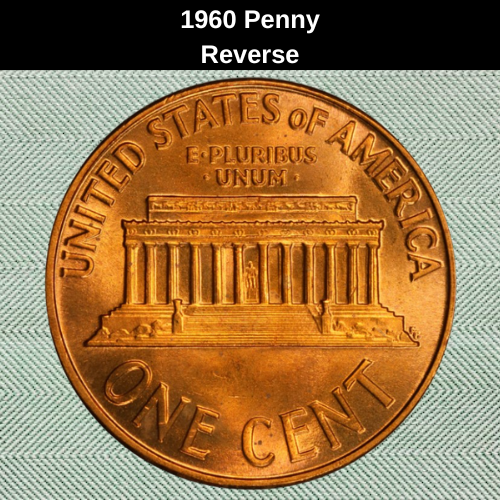
The reverse of the 1960 penny continued the design first introduced the previous year, featuring the Lincoln Memorial in Washington, D.C. This design replaced the earlier wheat ears and remained in use until 2008.
At the top of the coin, arching along the upper edge, is the inscription “UNITED STATES OF AMERICA.” Below that, just above the Memorial itself, appears the Latin motto “E PLURIBUS UNUM”, meaning “From the many, one” — a reference to the union of the individual states into one nation.
The denomination “ONE CENT” is boldly inscribed in large capital letters at the bottom, curving neatly along the lower edge of the coin.
Look closely at the Memorial, and you’ll even see a tiny depiction of Lincoln’s statue between the columns — making this one of the few coins in U.S. history to feature the same person on both the obverse and reverse.
Other Features of the 1960 Penny
The 1960 Lincoln pennies were struck in bronze, composed of 95% copper and 5% tin and zinc. This composition remained standard until 1962, when the tin was removed, and pennies were made from 95% copper and 5% zinc—a composition more accurately described as brass.
Each 1960 penny weighs 3.11 grams and measures 19 millimeters in diameter. Because of their high copper content, these coins can display a wide range of colors, from bright red when freshly minted, to dull brown as they age and oxidize from handling or exposure to air.
Color plays a major role in the value of copper coins. Professional grading services categorize Lincoln cents into three color designations:
- Red (RD): At least 95% of the coin’s surface retains its original red mint luster.
- Brown (BN): At least 95% of the surface has toned to brown.
- Red and Brown (RB): A mix of red and brown that doesn’t meet the threshold for either RD or BN.
All else being equal, red coins are the most desirable and valuable, followed by red and brown, with brown coins typically being the least valuable.
1960 Penny Grading Scale
Understanding your penny’s grade is essential to determining its value. Coins are graded on a scale from 1 to 70, with higher numbers indicating better condition:
| Grade Number | Grade Description |
|---|---|
| 1 | Basal State-1 (Barely identifiable) |
| 2 | Fair |
| 3 | Very Fair |
| 4–6 | Good |
| 7–10 | Very Good |
| 12–15 | Fine |
| 20–30 | Very Fine |
| 40 | Extremely Fine |
| 50 | About Uncirculated |
| 60 | Mint State (MS60) |
| 65 | Mint State (MS65 – Gem Quality) |
| 70 | Mint State (MS70 – Perfect) |
🔍 Tip: Be sure to consult a detailed grading guide or have your coin reviewed by a professional grading service like PCGS or NGC to determine its true condition and value.
1960 Penny Value Guides
1960 No Mint Mark Penny Value (Large Date)

In 1960, the Philadelphia Mint struck over 586 million Lincoln cents, including both large date and small date varieties. Today, it’s estimated that around 170,000 examples of the large date version still exist.
How to Identify the Large Date Variety
You can tell if your coin is a large date by looking closely at the numbers in the year:
- On a large date, the top of the “9” sits significantly higher than the “1”.
- The “6” is also noticeably larger compared to the one on a small date coin.
If you have both varieties side by side, the difference is easy to spot.
What’s It Worth?
Most 1960 large date pennies from Philadelphia are only worth face value — unless they’re in excellent condition and maintain their original red color. Copper coins darken over time, so coins that are still red (95% or more of their surface) are more desirable to collectors.
Here’s what red coins from this variety are typically worth, according to PCGS values:
| Grade (MS) | Estimated Value |
|---|---|
| MS65 | $14 |
| MS66 | $22 |
| MS67 | $375 |
| MS67+ (only 2 known) | $8,750 |
⚠️ Once you reach MS67 and above, these coins become much harder to find, and their value increases dramatically.
1960 No Mint Mark Penny Value (Small Date)
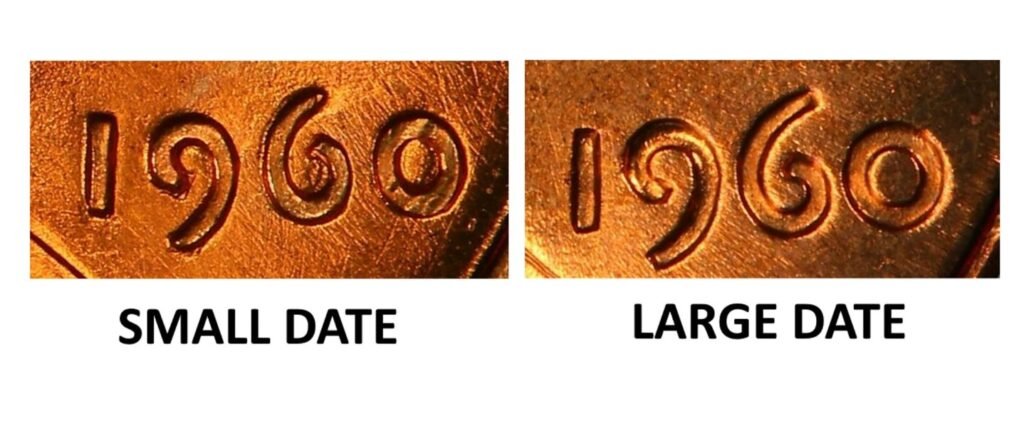
In 1960, the Philadelphia Mint struck a variety of pennies, including the small date version, but it’s not entirely clear how many were minted. The PCGS estimates that around 130,000 small date pennies remain, which is a bit fewer than the large date coins. This makes small date pennies relatively rarer, and consequently, they tend to carry a higher value.
Small Date vs. Large Date: Value Comparison
The general trend is that small date pennies have higher values, especially when they are red (unoxidized) and in mint state conditions.
Here’s a look at their values in different grades:
| Grade (MS) | Small Date Value | Large Date Value |
|---|---|---|
| MS65 | $27 | $14 |
| MS66 | $40 | $22 |
| MS67 | $525 | $375 |
| MS67+ (7 known) | $10,000 | $8,750 |
As you can see, a small date coin in MS65 is already worth $27, which is $13 more than a large date coin at the same grade.
And for those lucky enough to own a MS67+ small date penny, it could fetch a staggering $10,000, compared to $8,750 for the finest large date example.
1960 D Penny Value (Large Date)
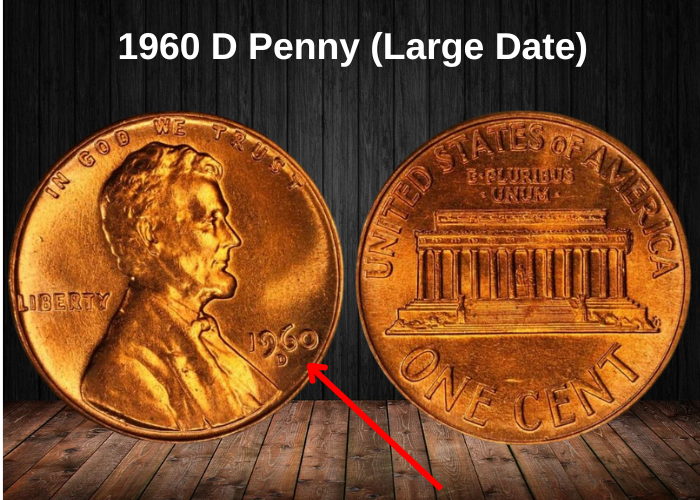
In 1960, the Denver Mint struck nearly three times as many pennies as the Philadelphia Mint, producing over 1.5 billion pennies. It’s estimated that around 120,000 of these Denver pennies still exist today, with roughly half of them being gem quality (graded MS65 or higher).
Large vs. Small Date in Denver:
Similar to the Philadelphia coins, the large date Denver pennies can be identified by the taller “9” and “6” in the year. The small date coins, on the other hand, feature smaller digits.
Value Comparison:
When it comes to value, red coins are the most valuable, while coins in circulated condition will be worth near face value. But if you have a red penny graded in mint state, especially in the higher grades, the value can be significantly higher than face value.
Here’s a breakdown of the values for 1960 Denver large date pennies based on their grades:
| Grade (MS) | Denver Large Date Value | Philadelphia Large Date Value |
|---|---|---|
| MS63 | $8 | $4 |
| MS65 | $16 | $14 |
| MS67 | $475 | $375 |
Notable Differences:
- A red MS63 1960 large date Denver penny is worth $8, which is twice as much as its Philadelphia counterpart.
- At MS65, the Denver penny holds a slight premium ($16 vs. $14 for Philly).
- But at MS67, the Denver penny jumps to $475, which is almost $100 more than the equivalent Philadelphia penny at the same grade.
1960 D Penny Value (Small Date)
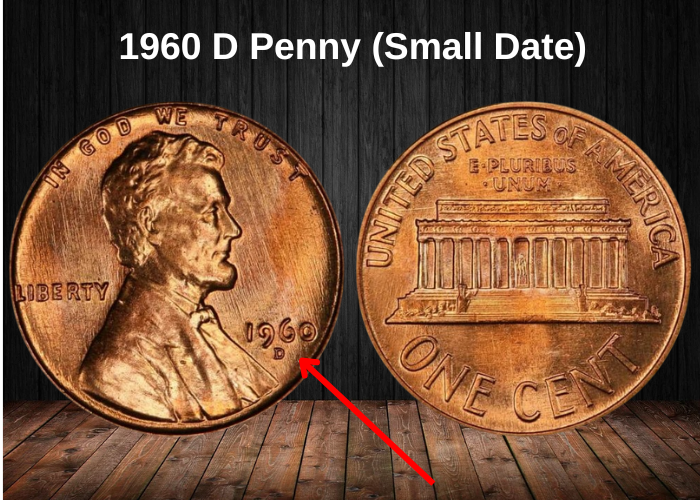
The 1960 small date Denver pennies are more common than their large date counterparts, with an estimated 180,000 still in existence. However, their distribution across grades is a bit different.
Small Date Denver Penny Value Breakdown:
While there are more small date Denver pennies overall, their distribution tends to favor higher grades, making them a bit more valuable in some cases. Here’s a look at the values based on different mint state grades:
| Grade (MS) | Small Date Denver Penny Value |
|---|---|
| MS63 | $10 |
| MS64 | $15 |
| MS65 | $20 |
| MS66 | $30 |
| MS67 | $340 |
| MS67+ | $4,000 |
Key Points:
- In lower grades (MS63-MS66), the small date Denver pennies are generally worth more than the large date version. For example, MS63 small date pennies are worth $10, compared to the $8 value of the large date variant.
- At MS67, the value of the small date increases significantly to $340.
- The finest examples of small date Denver pennies—graded MS67+—are extremely rare, with just nine known to exist. These coins are worth a stunning $4,000 each.
1960 (P) Proof Penny Value
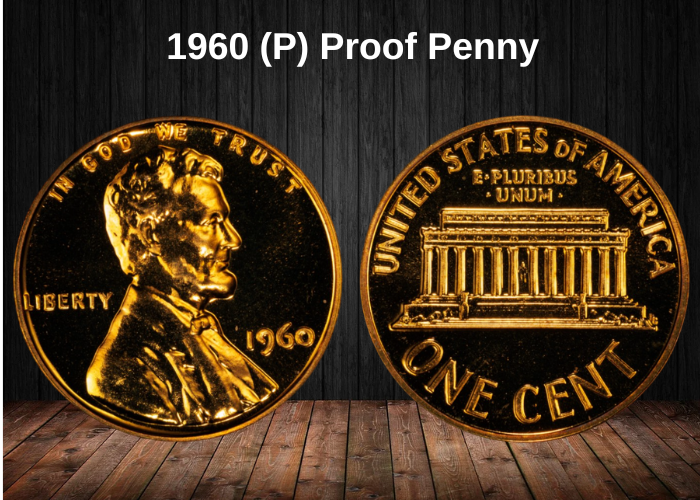
The 1960 proof pennies were produced for collectors at the Philadelphia Mint, with a total of nearly 1.7 million struck. These coins, like the business strikes, come in both large and small date variants, but they are more likely to be found in higher grades, making them more valuable.
1960 Proof Penny Values:
1. Red Proofs
- Large Date Red Proofs:
- PR60: $5
- PR69: $160
- Small Date Red Proofs:
- PR60: $6
- PR69: $625
2. Cameo Proofs
Cameos have a reflective field with frosted devices for contrast.
- Large Date Cameos:
- PR60: $7
- PR70: $2,100
- Small Date Cameos:
- PR60: $8
- PR70: $4,080 (auctioned in May 2023)
3. Deep Cameo Proofs
Deep Cameos show stronger contrast between the reflective background and frosted design.
- Large Date Deep Cameos:
- PR60: $8
- PR69: $2,650
- Small Date Deep Cameos:
- PR60: $8
- PR68+: $1,350 (three known)
Key Points:
- Red Proofs are relatively affordable at the lower grades but increase in value at higher grades.
- Cameo and Deep Cameo Proofs are much rarer and command a premium.
- Small Date Proofs, especially cameos and deep cameos, have higher values compared to their large date counterparts. Notably, PR70 small date cameos can fetch over $4,000 at auction!
Rare 1960 Penny Error List
1960 D Over D, Small Over Large Date Penny, Repunched Mint Mark
Some of the 1960 Denver pennies feature repunched mint marks, where a faint ghost “D” can be seen behind the second mint mark. This subtle error can be hard to detect without a microscope or loupe.
Additionally, a small over large date error occurred due to a die being struck first by a large date hub and then by a small date hub. This resulted in doubling on the date that transferred to the coins. The small over large date error adds significant value to the coins.
1960 Denver Small Over Large Date Penny Value:
- Brown Coins:
- Grade 8: Worth around $2.
- XF45 (Extremely Fine): $8.
- MS60 (Mint State): $34.
- MS65 (Mint State): $135.
- Red and Brown Mint State Coins:
- MS60: $50.
- MS66: $400 (the highest grade known for red and brown coins).
- Red Coins:
- MS60: $75.
- MS66+: $1,375.
Key Highlights:
- The small over large date error can greatly increase a coin’s value, particularly if it’s graded higher.
- Red coins and those with mint state grades are the most valuable.
- Even brown coins with this error can be worth multiple times their face value.
1960 (P) Small Over Large Date Proof Penny, Repunched Mint Mark
A similar hubbing error occurred with the 1960 (P) Small Over Large Date Proof Penny, which was struck at the Philadelphia Mint. This error involved three different proof dies, each being struck with both small and large date hubs.
- Two of the dies were first hubbed with the large date design, followed by the small date design, creating the small over large date variety.
- The third die was hubbed with the small date first, followed by the large date, resulting in the large over small date variety.
Value Breakdown for Small Over Large Date Proof Pennies:
- PR60 (Red or Cameo): $50
- PR69 (Red): $4,150 (highest value)
- PR66 (Deep Cameo): Around $2,000
Value Breakdown for Large Over Small Date Proof Pennies:
- PR60 (Red): $30
- PR60 (Cameo): $35
- PR68 (Cameo): $2,500
- PR69 (Red): $8,500 (highest value)
Key Points:
- The small over large date proof pennies are typically more valuable, with red PR69 examples being the most valuable at $4,150.
- Large over small date proof pennies, while valuable, generally have lower values, with red PR69 coins reaching $8,500 as the highest price.
- Cameo and deep cameo coins also bring a premium, particularly in high grades.
Where to sell your penny?
Now that you know the value of your penny, you might be wondering where to sell it. Don’t worry: here’s a guide to some of the best online platforms where you can easily sell your coins, along with their advantages and disadvantages.
Discover the best platforms for selling coins online (pros and cons).
FAQs
1. Why is the 1960 Lincoln Penny significant?
The 1960 Lincoln Penny is notable because it marks a key transition year in the U.S. Mint’s production of pennies. This was the first year of the modern Lincoln Memorial reverse design after the Wheat reverse design was phased out in 1958. The coin also holds importance because a new type of penny was introduced, with a change in the composition and the presence of certain error varieties that make it highly collectible.
2. What is the composition of the 1960 Lincoln Penny?
The 1960 Lincoln Penny is made of:
- 95% copper
- 5% zinc and tin
The coin weighs 3.11 grams, which is consistent with the standard weight for U.S. pennies minted from 1909 to 1982, before the introduction of the copper-plated zinc penny in 1982.
3. How many 1960 Lincoln Pennies were minted?
The total mintage for the 1960 Lincoln Penny was substantial. The breakdown is as follows:
- Philadelphia Mint (no mintmark): 1,214,083,000
- Denver Mint (D): 1,085,881,000
- San Francisco Mint (Proof coins): 1,741,503
This makes the 1960 Lincoln Penny a common coin overall, but its significance comes from the transition in design and the collectible error varieties that were discovered later.
4. Are there any notable errors or varieties with the 1960 Lincoln Penny?
Yes, the 1960 Lincoln Penny is famous for a few error varieties, including:
- 1960 Doubled Die Obverse: This is one of the most famous errors in U.S. numismatics. The doubling is visible on the word “LIBERTY” and “IN GOD WE TRUST” on the obverse. The doubling occurs because the coin die was struck twice, slightly offset each time, giving these inscriptions a doubled appearance. These are highly sought after and can be worth hundreds or even thousands of dollars in higher grades.
- 1960 Small Date vs. Large Date: The Small Date variety was produced by a different die that was used in the minting process, creating a distinct smaller number for the date compared to the Large Date variety. The Small Date version is considered rarer and more valuable, particularly in high-grade condition.
5. How does the 1960 Lincoln Penny compare to other years in the Lincoln Memorial series?
The 1960 Lincoln Penny is historically important because it marks the first year of the Lincoln Memorial reverse, and this design was used for 50 years, until 2008. While the mintage of the 1960 penny is relatively high, making it fairly easy to find in circulated condition, its error varieties like the Doubled Die and Small Date make it a key coin for collectors of the Lincoln Memorial series.
The Small Date variety, in particular, makes the 1960 penny more desirable than many other years in the Memorial series.
6. What is the value of a 1960 Lincoln Penny today?
The value of a 1960 Lincoln Penny depends on its condition and whether it is an error coin:
- Circulated coins: Typically worth 1 to 5 cents.
- Uncirculated MS-63: Worth around $0.50 to $1.
- High-grade uncirculated MS-65+: Can range from $5 to $20.
- Proof coins: Proof versions of the 1960 penny, minted at the San Francisco Mint, are worth about $5 to $10.
- 1960 Doubled Die Obverse: This error can be worth several hundred dollars depending on its grade.
- 1960 Small Date: The Small Date variety in high grades can be worth anywhere from $10 to $50 or more, depending on its condition.
7. How can I identify a high-grade 1960 Lincoln Penny?
To identify a high-grade 1960 Lincoln Penny, look for:
- Sharp Details: The Lincoln portrait, the wheat stalks, and the inscriptions should be crisp and clearly defined, with little to no visible wear.
- No visible wear: A high-grade coin will have no wear on the fields, the portrait, or the wheat stalks.
- Smooth surfaces: High-grade coins should have clean surfaces, free from scratches, nicks, and discoloration.
- Shiny luster: A coin graded MS-65 or higher will have a reflective surface and noticeable luster with minimal contact marks.


















































